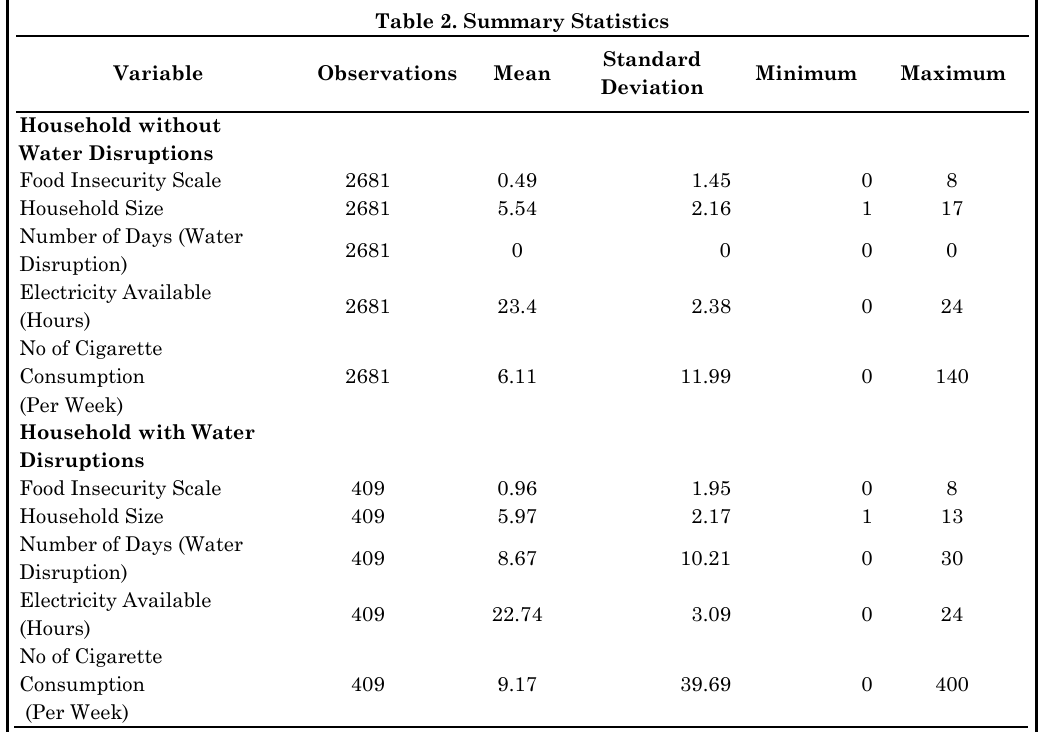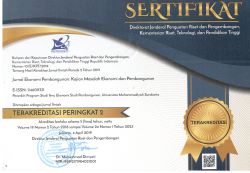Impact of Water Supply Disruption on Food Insecurity Experience: Evidence from Kyrgyz Farming Households
DOI:
https://doi.org/10.23917/jep.v26i1.12294Keywords:
Water supply disruption, Food insecurity, Kyrgyz farming households, Irrigation and agricultureAbstract
Farming households have to depend on uninterrupted water supply for their agriculture-based livelihood. Water supply disruption may endanger food security of farming households. However, there is not much evidence on the impact of water supply disruptions on food insecurity experience on farming households in Kyrgyzstan. Households with water supply disruptions can be systematically different from those without disruptions. The difference between treated and control units induce selection bias. To address potential selection biases arising from both observable and unobservable confounders, including geographic confounding where households in arid or infrastructure-poor areas face both higher water disruption and food insecurity, as well as other sources such as collider bias, this study applies fixed-effects models and reports random-effects estimates. The results suggest
consistently that water supply disruptions can increase food insecurity of farming households. While this study focuses on the effect of water disruption on food insecurity rather than on evaluating specific interventions, the findings highlight the need for policies that promote uninterrupted water supply, for example through resilient infrastructure, maintenance, and contingency planning, whose effectiveness should be examined in future research.
Downloads
References
Ahn, Y., & Juraev, Z. (2024). Examination of regional water governance and water insecurity issues in Central Asia. Sustainable Water Resources Management, 10(3). https://doi.org/10.1007/s40899-024-01099-y
Ahmed, M., Asim, M., Ahmad, S., & Aslam, M. (2023). Climate change, agricultural productivity, and food security. In Global agricultural production: Resilience to climate change (pp. 31-72). Cham: Springer International Publishing. https://doi.org/10.1007/978-3-031-14973-3_2
Amini, S., Delgado, M. S., Henderson, D. J., & Parmeter, C. F. (2012). Fixed vs Random: The Hausman Test Four Decades Later. In Advances in econometrics (pp. 479–513). https://doi.org/10.1108/s0731-9053(2012)0000029021
Bari, M. A., Haque, M. N., Khan, A., Uddin, M. A., Khan, G. D., & Yoshida, Y. (2024). Impact of cash assistance on food insecurity: a snapshot from Rohingya camps during COVID-19. Development in Practice, 34(6), 720-735. https://doi.org/10.1080/09614524.2024.236100
Bari, M. A., Khuram, M. A., Khan, G. D., & Bin Kamal, M. K. (2025). From revolution to inflation: the economic consequences of the Arab spring on Yemen's food prices. Humanities and Social Sciences Communications, 12(1), 1-8. https://doi.org/10.1057/s41599-025-05777-w
Bekturganov, Z., Tussupova, K., Berndtsson, R., Sharapatova, N., Aryngazin, K., & Zhanasova, M. (2016). Water related health problems in Central Asia—A review. Water, 8(6), 219. https://doi.org/10.3390/w8060219.
Bosire, C. K., Rao, E. J. O., Muchenje, V., Van Wijk, M., Ogutu, J. O., Mekonnen, M. M., Auma, J. O., Lukuyu, B., & Hammond, J. (2019). Adaptation opportunities for smallholder dairy farmers facing resource scarcity: Integrated livestock, water and land management. Agriculture Ecosystems & Environment, 284, 106592. https://doi.org/10.1016/j.agee.2019.106592
Breuer, M., & DeHaan, E. D. (2024). Using and interpreting fixed effects models. Journal of Accounting Research, 62(4), 1183-1226. https://doi.org/10.1111/1475-679X.12559
Cafiero, C., Viviani, S., & Nord, M. (2018). Food security measurement in a global context: The food insecurity experience scale. Measurement, 116, 146-152. https://doi.org/10.1016/j.measurement.2017.10.065
Datta, P., Behera, B., & Rahut, D. B. (2024). Climate change and water-related threats in the Indian Sundarbans: food security and management implications. International Journal of Water Resources Development, 40(3), 323–344. https://doi.org/10.1080/07900627.2023.2224459
Dieleman, J. L., & Templin, T. (2014). Random-Effects, Fixed-Effects and the within-between Specification for Clustered Data in Observational Health Studies: A Simulation Study. PLoS ONE, 9(10), e110257. https://doi.org/10.1371/journal.pone.0110257
Djoumessi Tiague, B. (2023). Floods, agricultural production, and household welfare: evidence from Tanzania. Environmental and Resource Economics, 85(2), 341-384. https://doi.org/10.1007/s10640-023-00769-3
Duchenne-Moutien, R. A., & Neetoo, H. (2021). Climate change and emerging food safety Issues: A review. Journal of Food Protection, 84(11), 1884–1897. https://doi.org/10.4315/jfp-21-141
Egamberdiev, B. (2023). Social capital effects on resilience to food insecurity: Evidence from Kyrgyzstan. Journal of International Development, 36(1), 435–450. https://doi.org/10.1002/jid.3826
Enfors, E. I., & Gordon, L. J. (2008). Dealing with drought: The challenge of using water system technologies to break dryland poverty traps. Global Environmental Change, 18(4), 607–616. https://doi.org/10.1016/j.gloenvcha.2008.07.006
Erickson, J. J., Quintero, Y. C., & Nelson, K. L. (2020). Characterizing supply variability and operational challenges in an intermittent water distribution network. Water, 12(8), 2143. https://doi.org/10.3390/w12082143
Foini, P., Tizzoni, M., Martini, G., Paolotti, D., & Omodei, E. (2023). On the forecastability of food insecurity. Scientific Reports, 13(1). https://doi.org/10.1038/s41598-023-29700-y
Hadley, K., Wheat, S., Rogers, H. H., Balakumar, A., Gonzales-Pacheco, D., Davis, S. S., ... and Sorensen, C. (2023). Mechanisms underlying food insecurity in the aftermath of climate-related shocks: a systematic review. The Lancet Planetary Health, 7(3), e242-e250. https://doi: 10.1016/S2542-5196(23)00003-7
Imai, K., and Kim, I. S. (2019). When we should use unit fixed effects regression models for causal inference with longitudinal data? American Journal of Political Science, 63(2), 467-490. https://doi.org/10.1111/ajps.12417
Khan, Y., Bojnec, Š., & Daraz, U. (2025). Infrastructure, knowledge and climate resilience technologies enhancing food security: Evidence from Northern Pakistan. Sustainable Futures. https://doi.org/10.1016/j.sftr.2025.100769
Kompas, T., Che, T. N., & Grafton, R. Q. (2024). Global impacts of heat and water stress on food production and severe food insecurity. Scientific Reports, 14(1), 14398. https://doi.org/10.1038/s41598-024-65274-z
Lutta, A. I., Wasonga, O. V., Nyangito, M. M., Sudan, F. K., & Robinson, L. W. (2020). Adoption of water harvesting technologies among agro-pastoralists in semi-arid rangelands of South Eastern Kenya. ENVIRONMENTAL SYSTEMS RESEARCH, 9(1). https://doi.org/10.1186/s40068-020-00202-4
Maleksaeidi, H., Karami, E., Zamani, G. H., Rezaei-Moghaddam, K., Hayati, D., & Masoudi, M. (2015). Discovering and characterizing farm households’ resilience under water scarcity. Environment Development and Sustainability, 18(2), 499–525. https://doi.org/10.1007/s10668-015-9661-y
Mehta, K., Ehrenwirth, M., Trinkl, C., Zörner, W., & Greenough, R. (2021). The Energy Situation in Central Asia: A Comprehensive energy review focusing on rural areas. Energies, 14(10), 2805. https://doi.org/10.3390/en14102805
Moahid, M., Khan, G. D., Bari, M. A., & Yoshida, Y. (2023). Does access to agricultural credit help disaster-affected farming households to invest more on agricultural input? Agricultural Finance Review, 83(1), 96-106. https://doi.org/10.1108/AFR-12-2021-0168
Nuralieva, N. M. (2022). Water Potential of the Republic of Kyrgyzstan: Problems and Potentials of Economic Development. Arid Ecosystems, 12(2), 193–199. https://doi.org/10.1134/s207909612202010x
Obeta, M. C., & Nwankwo, C. F. (2015). Factors responsible for rural residential water supply shortage in southeastern Nigeria. Journal of Environmental Geography, 8(3–4), 21–32. https://doi.org/10.1515/jengeo-2015-0009
Onyeaka, H., Nwauzoma, U. M., Akinsemolu, A. A., Tamasiga, P., Duan, K., Al-Sharify, Z. T., & Siyanbola, K. F. (2024). The ripple effects of climate change on agricultural sustainability and food security in Africa. Food and Energy Security, 13(5). https://doi.org/10.1002/fes3.567
Pradhan, R. (2021). Natural resources and violent conflicts: water and energy in Kyrgyzstan. Journal of Asian and African Studies, 57(4), 650–666. https://doi.org/10.1177/00219096211035166
Sarwary, M., Samiappan, S., Khan, G. D., & Moahid, M. (2023). Climate change and cereal crops productivity in Afghanistan: Evidence based on panel Regression model. Sustainability, 15(14), 10963. https://doi.org/10.3390/su151410963
Scott, C. K., Chi, G., & Glenna, L. (2024). Household food security in the agropastoral communities of rural southern Kyrgyzstan. Agriculture & Food Security, 13(1). https://doi.org/10.1186/s40066-024-00468-2
Sutcliffe, C., Knox, J., & Hess, T. (2021). Managing irrigation under pressure: how supply chain demands and environmental objectives drive imbalance in agricultural resilience to water shortages. Agricultural Water Management, 243, 106484.
Stavi, I., Paschalidou, A., Kyriazopoulos, A. P., Halbac-Cotoara-Zamfir, R., Siad, S. M., Suska-Malawska, M., Savic, D., De Pinho, J. R., Thalheimer, L., Williams, D. S., Hashimshony-Yaffe, N., Van Der Geest, K., Cordovil, C. M. D. S., & Ficko, A. (2021). Multidimensional Food Security Nexus in Drylands under the Slow Onset Effects of Climate Change. Land, 10(12), 1350. https://doi.org/10.3390/land10121350
Sumastuti, E. (2015). The Empowerment Strategy for the Food Crop Farmers in Anticipating the climate change. Jurnal Ekonomi Pembangunan Kajian Masalah Ekonomi Dan Pembangunan, 16(2), 131. https://doi.org/10.23917/jep.v16i2.1458
The World Bank. (2025). Listening to the Kyrgyz Republic Survey 2021-2025 [Data set]. World Bank, Development Data Group. https://doi.org/10.48529/SWMC-AQ82
Umayah, U., & Suryanto, S. (2020). Measuring farmers risk aversion in facing climate change in Bengawan Solo Watershed. Jurnal Ekonomi Pembangunan Kajian Masalah Ekonomi Dan Pembangunan, 21(2), 91–100. https://doi.org/10.23917/jep.v21i2.7958
Ville, A. S., Po, J. Y. T., Sen, A., Bui, A., & Melgar-Quiñonez, H. (2019). Food security and the Food Insecurity Experience Scale (FIES): ensuring progress by 2030. Food Security, 11(3), 483–491. https://doi.org/10.1007/s12571-019-00936-9
Winsemius, H. C., Jongman, B., Veldkamp, T. I., Hallegatte, S., Bangalore, M., & Ward, P. J. (2018). Disaster risk, climate change, and poverty: assessing the global exposure of poor people to floods and droughts. Environment and Development Economics, 23(3), 328–348. https://doi.org/10.1017/s1355770x17000444
Yildiz, V., Hatipoglu, M. A., & Kumcu, S. Y. (2022). Climate change impacts on water resources. In Water and wastewater management: global problems and measures (pp. 17-25). Cham: Springer International Publishing. https://doi.org/10.1007/978-3-030-95288-4_2
Zhalil, G., & Duishebaeva, G. (2024). Strengthening the human resource potential as a basis for the development of the potable water supply and disposal sector of the Kyrgyz Republic. BIO Web of Conferences, 107, 05003. https://doi.org/10.1051/bioconf/202410705003

Downloads
Submitted
Accepted
Published
How to Cite
Issue
Section
License
Copyright (c) 2025 Yoshinari Kajishita, Md Abdul Bari, Md Khalid Bin Kamal, Muhammad Ibrahim Khan

This work is licensed under a Creative Commons Attribution 4.0 International License.













